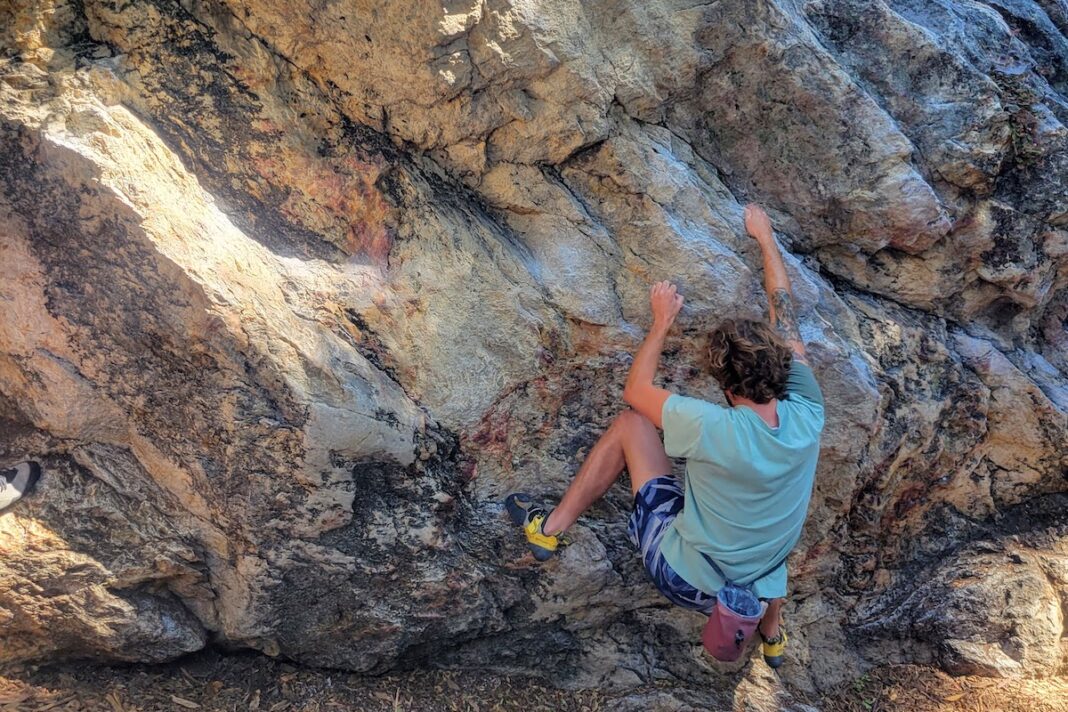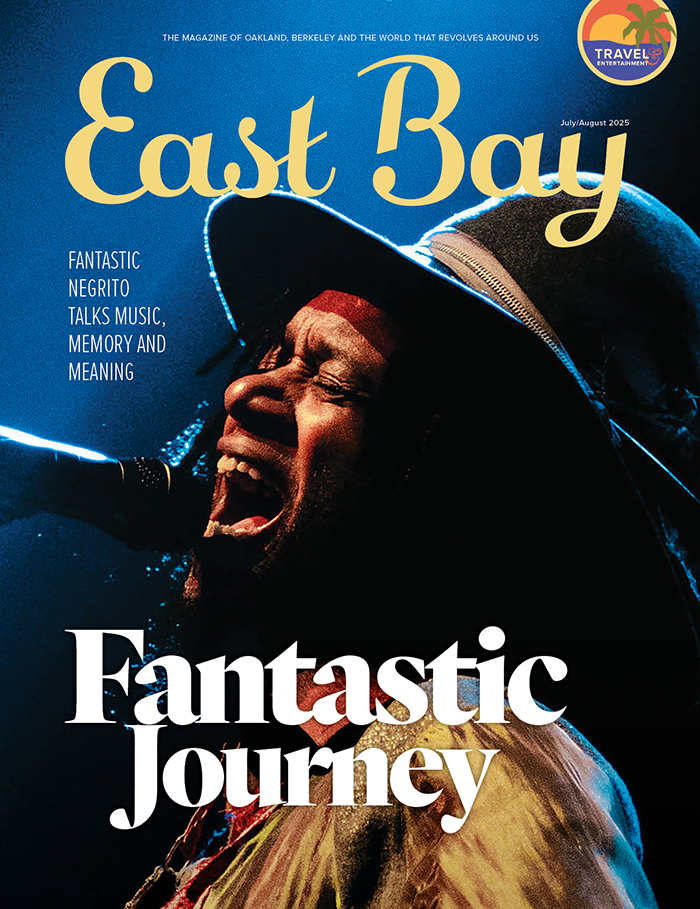In the heart of residential North Berkeley lives a cluster of unexpected giants: giant hunks of rhyolite, lava remnants created by volcanic eruptions 10 million years ago. Their history is visible on their surface, starting with the flat planes and edges sanded to smoothness as the boulders were carried along the Hayward fault, eventually landing in what is now Berkeley’s Northbrae neighborhood.
Over the millennia, humans have sought out these boulders for their own purposes, both practical and recreational, and left their marks on the rock. The Huichin band of the Ohlones used them to grind acorns into fine flour with a pestle in order to leach out the acorn meat’s bitter tannins—at Mortar Rock Park, one can see the deep holes worn into the rock over hundreds of years of grinding.
As the 20th century rolled around, these boulders became an open-air laboratory for early mountaineers and rock climbers. In the 1930s, pioneers of California climbing experimented with new techniques and gear such as pitons, metal spikes hammered into seams and cracks to act as anchors to protect climbers from falls.
With these new protection techniques, Berkeley-based climbers like Dick Leonard and David Brower were able to complete first ascents of High Sierra peaks that had been thought unclimbable. Their practice pitons left scars in the stone that one can still find in the nooks and crannies of Indian Rock and Cragmont Rock parks.
Climbing techniques have continued to evolve—modern climbers generally use either permanent, drilled-in bolts or removable “cams” and “nuts” that leave less scarring on the rock—but much of the essence of Yosemite climbing is founded on the techniques developed in North Berkeley by the Cragmont Climbing Club.
Now, Berkeley’s rock parks bustle with people taking advantage of everything these friendly neighborhood behemoths have to offer: climbing, scrambling, people-watching and panoramic views of the bay. Indian Rock Park in the evening is full of runners jogging up the carved stone steps, friends sitting atop the rock to wait for sunset, puppies in training digging in the wood chips below, kids rock-hopping and the odd teenager carving their initials into the stone. And then, there are the boulderers—those who seek the thrill of rock climbing without venturing far from the ground.
Bouldering is a puzzle-solving-oriented type of climbing. The goal is to get from point A to point B—sometimes above, sometimes to the left or right—without touching the ground. Berkeley’s outdoor bouldering holds appeal for a wide variety of ages and skill levels—there’s always a contingent of graduate students sharing strategies and analyzing their body positioning, kids appreciating its “The Floor is Lava” appeal (a misleading image here, since the walls are actually lava) and seasoned Yosemite climbers staying in shape when they’re out of the valley.
In fact, one of the beginner-friendly walls in Mortar Rock Park is named “Little Half Dome,” after the iconic Yosemite landmark. One will see everyone from chalked-up acrobats moving gracefully across vertical rock like lizards to first-timers breaking in the grippy rubber on their new climbing shoes.
Generally, boulderers try to complete “problems,” specific routes with a set beginning and end, which each climber might do with a slightly different sequence of moves. Boulder problems are often named with the flair of racehorses—at Indian Rock, one can find “Tea for Two” and “Embryonic Journey”; Mortar Rock features “Baby Nat’s Plague” and “Sunshine Elluminati.”
Boulder problems are rated by difficulty, with “V0” being the easiest. The hardest route in Berkeley, the “Impossible Wall Traverse” at Mortar Rock, is a V13 completed successfully by only a handful of elite climbers. But if one is a first-timer seeing if they might catch the bug, they should ignore the established routes and just see how far they can get without touching down.
Berkeley’s urban bouldering is especially beginner-friendly because one can make their way along the sides of the rock without getting too high off the ground. Then they can try moving sideways, not up, traversing paths that keep them no more than two feet above the earth. The white chalky spots are clues, revealing the most useful handholds discovered by past climbers following the same route.
When minute rock features are the difference between “sending”—completing—a boulder problem and falling, climbers become amateur geologists. As they climb, they may notice the quartz-rich pocket that makes a great handhold but scrapes fingertips, or the planar flow banding, layers formed in the rock as the viscous volcanic flow cooled and fractured, too smooth for fingers to catch on but just ridgy enough for climbing shoe to stick to. Thanks to the Northbrae Rhyolite’s high silica content, even the tiniest nub can hold one’s weight, if they dare trust their feet.
Berkeley’s rock parks are all scattered within a mile or two of each other—Indian Rock and Mortar Rock are just across the street from each other on Indian Rock Avenue, and Cragmont and Remillard Rock Parks are a five-minute drive away. Tiny Grotto Rock Park is right in the middle, on Santa Barbara Road.
To boulder, one will need at least climbing shoes. If someone wants to be able to try climbing more than a foot or two off the ground, they could consider borrowing or renting a crash pad to fall on. And finally, they’ll want climbing chalk to keep their hands dry—and to let them leave their own temporary mark on the ancient boulders of North Berkeley.











